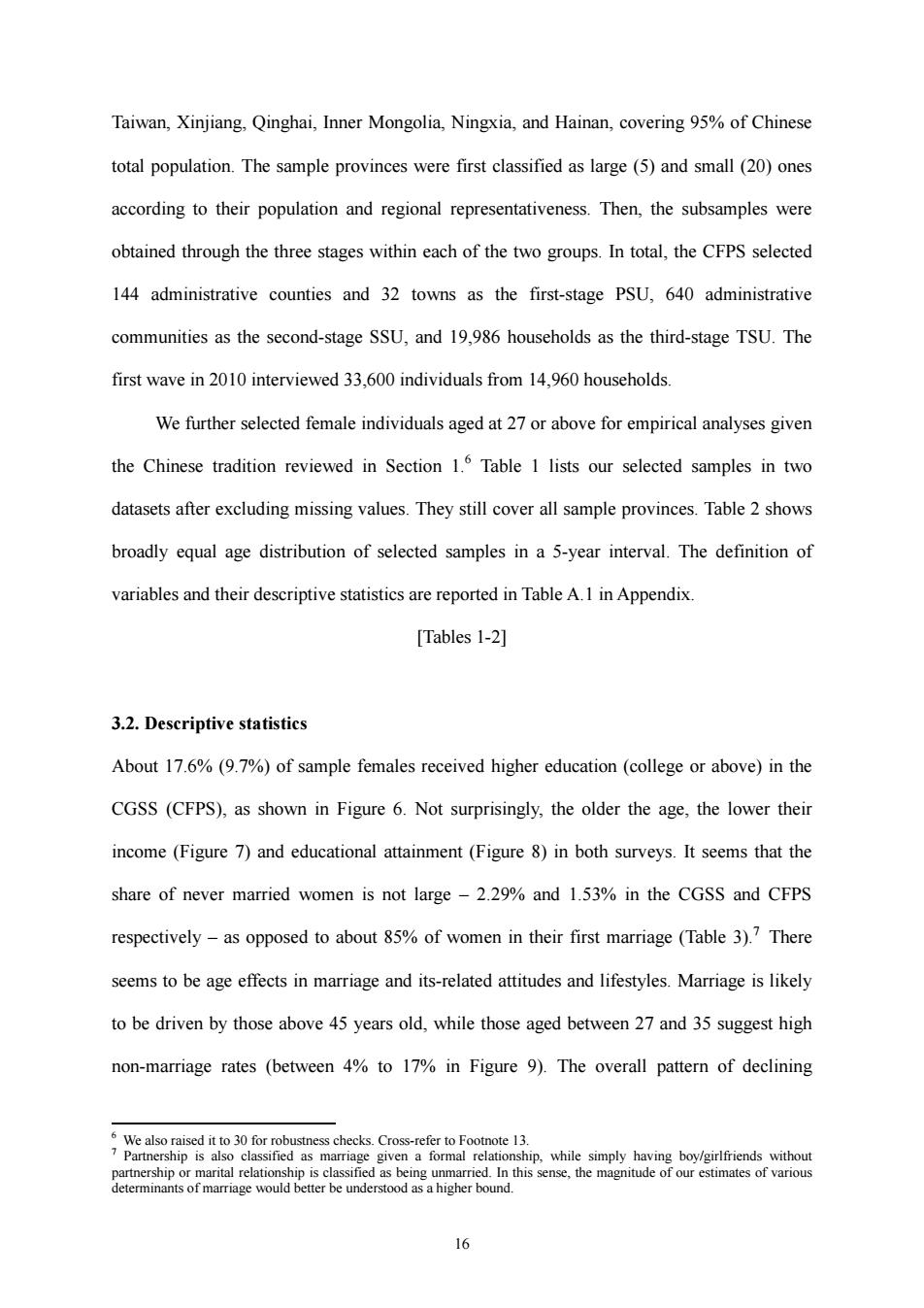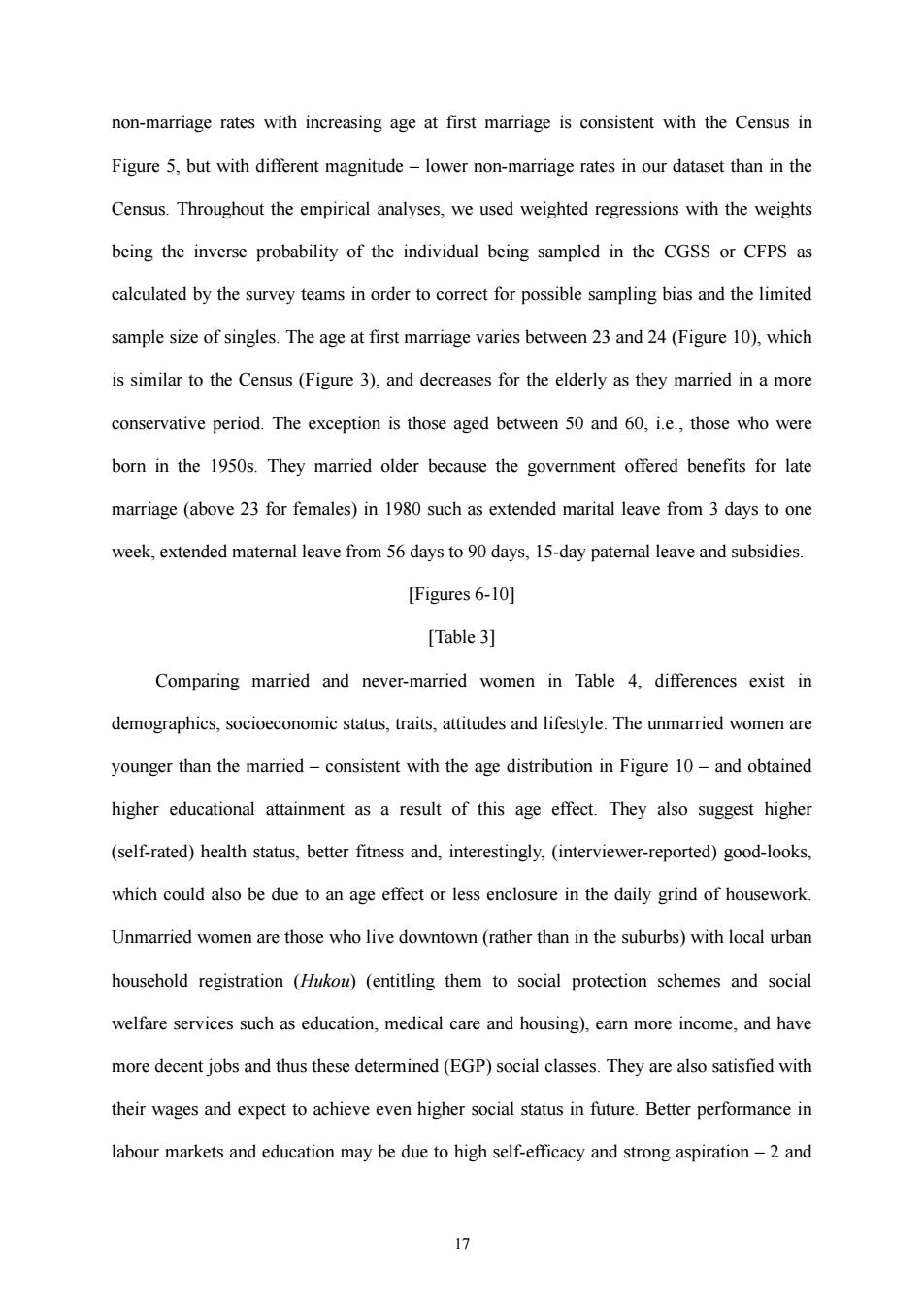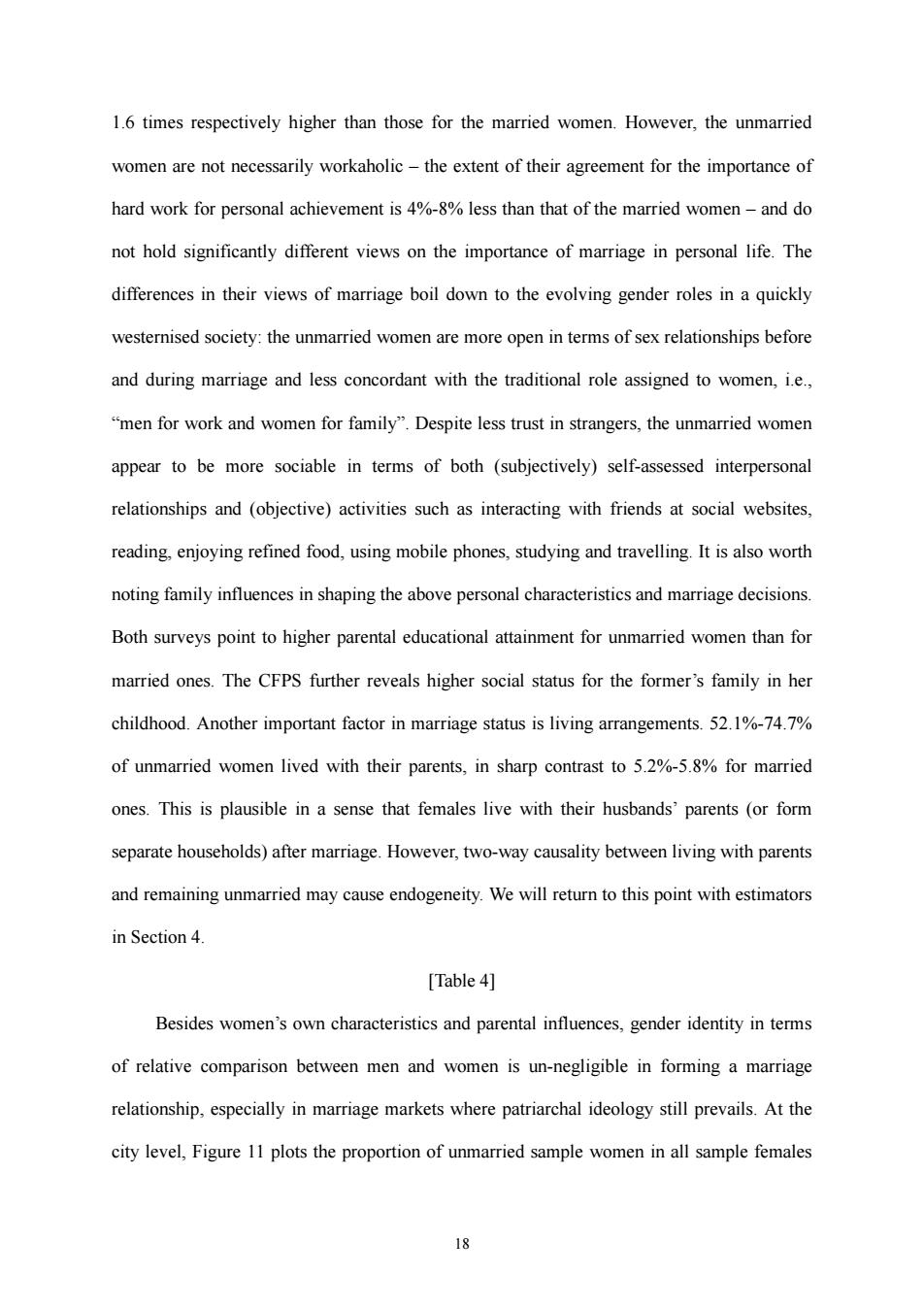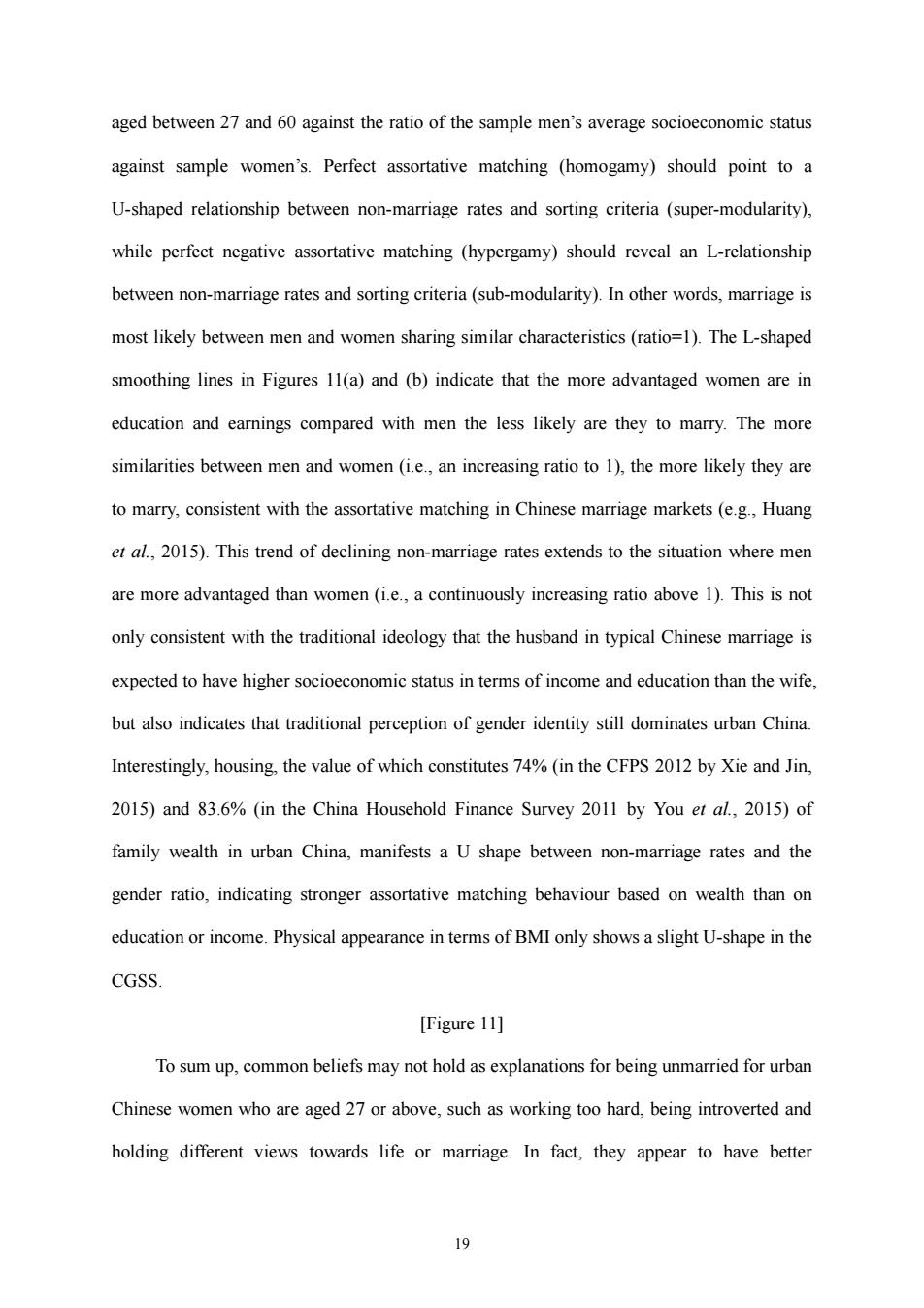
Taiwan,Xinjiang,Qinghai,Inner Mongolia,Ningxia,and Hainan,covering 95%of Chinese total population.The sample provinces were first classified as large (5)and small(20)ones according to their population and regional representativeness.Then,the subsamples were obtained through the three stages within each of the two groups.In total,the CFPS selected 144 administrative counties and 32 towns as the first-stage PSU,640 administrative communities as the second-stage SSU,and 19,986 households as the third-stage TSU.The first wave in 2010 interviewed 33,600 individuals from 14,960 households. We further selected female individuals aged at 27 or above for empirical analyses given the Chinese tradition reviewed in Section 1.Table 1 lists our selected samples in two datasets after excluding missing values.They still cover all sample provinces.Table 2 shows broadly equal age distribution of selected samples in a 5-year interval.The definition of variables and their descriptive statistics are reported in Table A.1 in Appendix. [Tables 1-2] 3.2.Descriptive statistics About 17.6%(9.7%)of sample females received higher education (college or above)in the CGSS(CFPS),as shown in Figure 6.Not surprisingly,the older the age,the lower their income (Figure 7)and educational attainment (Figure 8)in both surveys.It seems that the share of never married women is not large -2.29%and 1.53%in the CGSS and CFPS respectively-as opposed to about 85%of women in their first marriage (Table 3).7 There seems to be age effects in marriage and its-related attitudes and lifestyles.Marriage is likely to be driven by those above 45 years old,while those aged between 27 and 35 suggest high non-marriage rates (between 4%to 17%in Figure 9).The overall pattern of declining 6We also raised it to 30 for robustness checks.Cross-refer to Footnote 13. 7 Partnership is also classified as marriage given a formal relationship,while simply having boy/girlfriends without partnership or marital relationship is classified as being unmarried.In this sense,the magnitude of our estimates of various determinants of marriage would better be understood as a higher bound. 16
16 Taiwan, Xinjiang, Qinghai, Inner Mongolia, Ningxia, and Hainan, covering 95% of Chinese total population. The sample provinces were first classified as large (5) and small (20) ones according to their population and regional representativeness. Then, the subsamples were obtained through the three stages within each of the two groups. In total, the CFPS selected 144 administrative counties and 32 towns as the first-stage PSU, 640 administrative communities as the second-stage SSU, and 19,986 households as the third-stage TSU. The first wave in 2010 interviewed 33,600 individuals from 14,960 households. We further selected female individuals aged at 27 or above for empirical analyses given the Chinese tradition reviewed in Section 1.6 Table 1 lists our selected samples in two datasets after excluding missing values. They still cover all sample provinces. Table 2 shows broadly equal age distribution of selected samples in a 5-year interval. The definition of variables and their descriptive statistics are reported in Table A.1 in Appendix. [Tables 1-2] 3.2. Descriptive statistics About 17.6% (9.7%) of sample females received higher education (college or above) in the CGSS (CFPS), as shown in Figure 6. Not surprisingly, the older the age, the lower their income (Figure 7) and educational attainment (Figure 8) in both surveys. It seems that the share of never married women is not large – 2.29% and 1.53% in the CGSS and CFPS respectively – as opposed to about 85% of women in their first marriage (Table 3).7 There seems to be age effects in marriage and its-related attitudes and lifestyles. Marriage is likely to be driven by those above 45 years old, while those aged between 27 and 35 suggest high non-marriage rates (between 4% to 17% in Figure 9). The overall pattern of declining 6 We also raised it to 30 for robustness checks. Cross-refer to Footnote 13. 7 Partnership is also classified as marriage given a formal relationship, while simply having boy/girlfriends without partnership or marital relationship is classified as being unmarried. In this sense, the magnitude of our estimates of various determinants of marriage would better be understood as a higher bound

non-marriage rates with increasing age at first marriage is consistent with the Census in Figure 5,but with different magnitude-lower non-marriage rates in our dataset than in the Census.Throughout the empirical analyses,we used weighted regressions with the weights being the inverse probability of the individual being sampled in the CGSS or CFPS as calculated by the survey teams in order to correct for possible sampling bias and the limited sample size of singles.The age at first marriage varies between 23 and 24(Figure 10),which is similar to the Census(Figure 3),and decreases for the elderly as they married in a more conservative period.The exception is those aged between 50 and 60,i.e.,those who were born in the 1950s.They married older because the government offered benefits for late marriage (above 23 for females)in 1980 such as extended marital leave from 3 days to one week,extended maternal leave from 56 days to 90 days,15-day paternal leave and subsidies. [Figures 6-10] [Table 3] Comparing married and never-married women in Table 4,differences exist in demographics,socioeconomic status,traits,attitudes and lifestyle.The unmarried women are younger than the married-consistent with the age distribution in Figure 10-and obtained higher educational attainment as a result of this age effect.They also suggest higher (self-rated)health status,better fitness and,interestingly,(interviewer-reported)good-looks, which could also be due to an age effect or less enclosure in the daily grind of housework. Unmarried women are those who live downtown(rather than in the suburbs)with local urban household registration (Hukou)(entitling them to social protection schemes and social welfare services such as education,medical care and housing),earn more income,and have more decent jobs and thus these determined(EGP)social classes.They are also satisfied with their wages and expect to achieve even higher social status in future.Better performance in labour markets and education may be due to high self-efficacy and strong aspiration-2 and 17
17 non-marriage rates with increasing age at first marriage is consistent with the Census in Figure 5, but with different magnitude – lower non-marriage rates in our dataset than in the Census. Throughout the empirical analyses, we used weighted regressions with the weights being the inverse probability of the individual being sampled in the CGSS or CFPS as calculated by the survey teams in order to correct for possible sampling bias and the limited sample size of singles. The age at first marriage varies between 23 and 24 (Figure 10), which is similar to the Census (Figure 3), and decreases for the elderly as they married in a more conservative period. The exception is those aged between 50 and 60, i.e., those who were born in the 1950s. They married older because the government offered benefits for late marriage (above 23 for females) in 1980 such as extended marital leave from 3 days to one week, extended maternal leave from 56 days to 90 days, 15-day paternal leave and subsidies. [Figures 6-10] [Table 3] Comparing married and never-married women in Table 4, differences exist in demographics, socioeconomic status, traits, attitudes and lifestyle. The unmarried women are younger than the married – consistent with the age distribution in Figure 10 – and obtained higher educational attainment as a result of this age effect. They also suggest higher (self-rated) health status, better fitness and, interestingly, (interviewer-reported) good-looks, which could also be due to an age effect or less enclosure in the daily grind of housework. Unmarried women are those who live downtown (rather than in the suburbs) with local urban household registration (Hukou) (entitling them to social protection schemes and social welfare services such as education, medical care and housing), earn more income, and have more decent jobs and thus these determined (EGP) social classes. They are also satisfied with their wages and expect to achieve even higher social status in future. Better performance in labour markets and education may be due to high self-efficacy and strong aspiration – 2 and

1.6 times respectively higher than those for the married women.However,the unmarried women are not necessarily workaholic-the extent of their agreement for the importance of hard work for personal achievement is 4%-8%less than that of the married women-and do not hold significantly different views on the importance of marriage in personal life.The differences in their views of marriage boil down to the evolving gender roles in a quickly westernised society:the unmarried women are more open in terms of sex relationships before and during marriage and less concordant with the traditional role assigned to women,i.e., "men for work and women for family".Despite less trust in strangers,the unmarried women appear to be more sociable in terms of both (subjectively)self-assessed interpersonal relationships and (objective)activities such as interacting with friends at social websites, reading,enjoying refined food,using mobile phones,studying and travelling.It is also worth noting family influences in shaping the above personal characteristics and marriage decisions. Both surveys point to higher parental educational attainment for unmarried women than for married ones.The CFPS further reveals higher social status for the former's family in her childhood.Another important factor in marriage status is living arrangements.52.1%-74.7% of unmarried women lived with their parents,in sharp contrast to 5.2%-5.8%for married ones.This is plausible in a sense that females live with their husbands'parents (or form separate households)after marriage.However,two-way causality between living with parents and remaining unmarried may cause endogeneity.We will return to this point with estimators in Section 4. [Table 4] Besides women's own characteristics and parental influences,gender identity in terms of relative comparison between men and women is un-negligible in forming a marriage relationship,especially in marriage markets where patriarchal ideology still prevails.At the city level,Figure 11 plots the proportion of unmarried sample women in all sample females 18
18 1.6 times respectively higher than those for the married women. However, the unmarried women are not necessarily workaholic – the extent of their agreement for the importance of hard work for personal achievement is 4%-8% less than that of the married women – and do not hold significantly different views on the importance of marriage in personal life. The differences in their views of marriage boil down to the evolving gender roles in a quickly westernised society: the unmarried women are more open in terms of sex relationships before and during marriage and less concordant with the traditional role assigned to women, i.e., “men for work and women for family”. Despite less trust in strangers, the unmarried women appear to be more sociable in terms of both (subjectively) self-assessed interpersonal relationships and (objective) activities such as interacting with friends at social websites, reading, enjoying refined food, using mobile phones, studying and travelling. It is also worth noting family influences in shaping the above personal characteristics and marriage decisions. Both surveys point to higher parental educational attainment for unmarried women than for married ones. The CFPS further reveals higher social status for the former’s family in her childhood. Another important factor in marriage status is living arrangements. 52.1%-74.7% of unmarried women lived with their parents, in sharp contrast to 5.2%-5.8% for married ones. This is plausible in a sense that females live with their husbands’ parents (or form separate households) after marriage. However, two-way causality between living with parents and remaining unmarried may cause endogeneity. We will return to this point with estimators in Section 4. [Table 4] Besides women’s own characteristics and parental influences, gender identity in terms of relative comparison between men and women is un-negligible in forming a marriage relationship, especially in marriage markets where patriarchal ideology still prevails. At the city level, Figure 11 plots the proportion of unmarried sample women in all sample females

aged between 27 and 60 against the ratio of the sample men's average socioeconomic status against sample women's.Perfect assortative matching (homogamy)should point to a U-shaped relationship between non-marriage rates and sorting criteria (super-modularity), while perfect negative assortative matching (hypergamy)should reveal an L-relationship between non-marriage rates and sorting criteria(sub-modularity).In other words,marriage is most likely between men and women sharing similar characteristics(ratio=1).The L-shaped smoothing lines in Figures 11(a)and(b)indicate that the more advantaged women are in education and earnings compared with men the less likely are they to marry.The more similarities between men and women(i.e.,an increasing ratio to 1),the more likely they are to marry,consistent with the assortative matching in Chinese marriage markets(e.g.,Huang et al.,2015).This trend of declining non-marriage rates extends to the situation where men are more advantaged than women (i.e.,a continuously increasing ratio above 1).This is not only consistent with the traditional ideology that the husband in typical Chinese marriage is expected to have higher socioeconomic status in terms of income and education than the wife, but also indicates that traditional perception of gender identity still dominates urban China. Interestingly,housing,the value of which constitutes 74%(in the CFPS 2012 by Xie and Jin, 2015)and 83.6%(in the China Household Finance Survey 2011 by You et al.,2015)of family wealth in urban China,manifests a U shape between non-marriage rates and the gender ratio,indicating stronger assortative matching behaviour based on wealth than on education or income.Physical appearance in terms of BMI only shows a slight U-shape in the CGSS. [Figure 11] To sum up,common beliefs may not hold as explanations for being unmarried for urban Chinese women who are aged 27 or above,such as working too hard,being introverted and holding different views towards life or marriage.In fact,they appear to have better 19
19 aged between 27 and 60 against the ratio of the sample men’s average socioeconomic status against sample women’s. Perfect assortative matching (homogamy) should point to a U-shaped relationship between non-marriage rates and sorting criteria (super-modularity), while perfect negative assortative matching (hypergamy) should reveal an L-relationship between non-marriage rates and sorting criteria (sub-modularity). In other words, marriage is most likely between men and women sharing similar characteristics (ratio=1). The L-shaped smoothing lines in Figures 11(a) and (b) indicate that the more advantaged women are in education and earnings compared with men the less likely are they to marry. The more similarities between men and women (i.e., an increasing ratio to 1), the more likely they are to marry, consistent with the assortative matching in Chinese marriage markets (e.g., Huang et al., 2015). This trend of declining non-marriage rates extends to the situation where men are more advantaged than women (i.e., a continuously increasing ratio above 1). This is not only consistent with the traditional ideology that the husband in typical Chinese marriage is expected to have higher socioeconomic status in terms of income and education than the wife, but also indicates that traditional perception of gender identity still dominates urban China. Interestingly, housing, the value of which constitutes 74% (in the CFPS 2012 by Xie and Jin, 2015) and 83.6% (in the China Household Finance Survey 2011 by You et al., 2015) of family wealth in urban China, manifests a U shape between non-marriage rates and the gender ratio, indicating stronger assortative matching behaviour based on wealth than on education or income. Physical appearance in terms of BMI only shows a slight U-shape in the CGSS. [Figure 11] To sum up, common beliefs may not hold as explanations for being unmarried for urban Chinese women who are aged 27 or above, such as working too hard, being introverted and holding different views towards life or marriage. In fact, they appear to have better

socioeconomic status,enjoy a diversified as well as open life,and perceive marriage similarly to those who do marry.The original family matters.Further,gender identity still prevails in urban marriage markets.More advantaged women compared with men in the same city are less likely to marry.These observations are consistent with persistence of traditional patriarchal gender norms reviewed in Section 2 and motivate our selection of covariates in the empirical model in the next section. 4.Methodology The sample woman is indexed by i at time t.She earns an annual income y and has educational attainment e,which is a categorical variable.Her marriage status is denoted by m,which is a binary variable with the value of 1 for singles and zero otherwise.This individual's income,education and marriage status is described by the following system: In yu =a+xBu+xB2+xpB13 +ZiB+euen+012mu+Eu (1) l,ifc<en≤c 2,ifC<em≤C2 ei= (2) 7,fc6<em≤c e=a2+xB2+xB22+xpB23+ZB2+021Inya+022mm+2m (3) m=1(m>0) (4) mi=as+xBs +xBs2+xpB33+Z3Bs+0s1 In ya +e2en+83 (5) where a=()are constants;the vectors x,x and x control for factors at the individual,household and provincial levels separately which are supposed to affect all three outcomes.Specifically,x includes individual demographics such as age,ethnicity,religious belief,self-reported health status,labour supply measured by working hours per day,and 20
20 socioeconomic status, enjoy a diversified as well as open life, and perceive marriage similarly to those who do marry. The original family matters. Further, gender identity still prevails in urban marriage markets. More advantaged women compared with men in the same city are less likely to marry. These observations are consistent with persistence of traditional patriarchal gender norms reviewed in Section 2 and motivate our selection of covariates in the empirical model in the next section. 4. Methodology The sample woman is indexed by i at time t . She earns an annual income it y and has educational attainment it e which is a categorical variable. Her marriage status is denoted by mit which is a binary variable with the value of 1 for singles and zero otherwise. This individual’s income, education and marriage status is described by the following system: 1 11 12 13 1 14 11 12 1 ln it i h p it it it y e m x x x z (1) * 0 1 * 1 2 * 6 7 1, 2, 7, it it it it if c e c if c e c e if c e c (2) * 2 21 22 23 2 24 21 22 2 e y m it i h p it it it x x x z ln (3) * 0 m m it it 1 (4) * 3 31 32 33 3 34 31 32 3 m y e it i h p it it it x x x z ln (5) where 1 2 3 , , α are constants; the vectors i x , h x and p x control for factors at the individual, household and provincial levels separately which are supposed to affect all three outcomes. Specifically, i x includes individual demographics such as age, ethnicity, religious belief, self-reported health status, labour supply measured by working hours per day, and